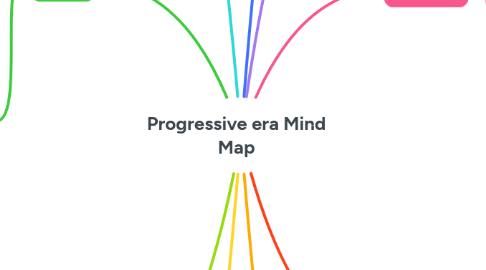
1. Workers Rights
1.1. Problems
1.1.1. Low wages- Factory workers were paid low wages
1.1.2. Long work days- The workers had long work days for bad wages
1.2. Solution
1.2.1. Labor unions- Workers joined together to make their jobs easier for their wage and long work hours
1.2.2. American Federation of Labor- Changed work hours per day and got workers a higher wage
1.3. Reformers
1.3.1. Samuel Gompers- Created the American Federation of Labor
1.3.2. AFL- Changed work hours and had many people in it
2. Racism
2.1. Problem
2.1.1. Jim Crow Laws- Which was meant to enforce segregation.
2.1.2. Segregation- Separation of whites and blacks, in public places like schools.
2.2. Solution
2.2.1. The N.A.A.C.P- which worked to end discrimination.
2.2.2. Tuskegee institute- Helped African Americans gain trade and economic strength
2.3. Reformers
2.3.1. Ida B. Wells- Journalist who worked to get rid of black lynchings.
2.3.2. W.E.B. Dubois- Helped start the National association for the advancement of colored people.
2.3.3. Booker T. Washington- Founded the Tuskegee institute.
3. Prohibition
3.1. Problem
3.1.1. Alcoholism- Was connected to Insanity and violence which led to poverty
3.1.2. Immorality- Gambling and destruction of families
3.2. Solution
3.2.1. Temperance Movement- calling for a ban of alcohol to put a stop to society's evil
3.3. Reformers
3.3.1. Mary Hunt- Supported of the Prohibition of Alcohol
3.3.2. Carrie Nation- Brought a hatchet to saloons and preached about the evils of alcohol
4. Conservation
4.1. Problem
4.1.1. Loss of natural resources- Losing of trees and wood and stuff we need.
4.2. Solution
4.2.1. Wildlife Refuge- Can't hunt in that specific area or do anything to the animals or resources there
4.2.2. National parks- More national parks were made.
4.3. Reformers
4.3.1. Theodore Roosevelt- Controlled how America's resources was used.
4.3.2. John Muir- Preserved Yosemite and other places
5. Poverty
5.1. Problem
5.1.1. Crowded tenements- run down buildings
5.1.2. Urban slums- to many people in one area
5.2. Solution
5.2.1. Settlement houses for immigrants or people in poverty.
5.3. Reformers
5.3.1. Jacob A Riis- Took pictures of Urban Slums and it shocked people and they made laws to help the poor people
5.3.2. Jane Addams- Bought houses and turned them into settlements
6. Corruption
6.1. Problem
6.1.1. Political Machine- Organizations that influenced votes and controlled local governments
6.2. Solution
6.2.1. Direct primary- Voters chose candidates for the parties to run
6.3. Reformers
6.3.1. Robert M La Follete- Made Wisconsin the first state to have a direct Primary
7. Child labor
7.1. Problem
7.1.1. Child labor- Children had no education and were working in factories because there family needed money
7.2. Solution
7.2.1. National Child Labor Committee- ended all child labor and made compulsory education.
7.3. Reformers
8. Health and Safety
8.1. Problem
8.1.1. Contaminated food- Food or medicine was unsafe for people
8.1.2. Lack Of healthcare- Not much people getting the health care stuff they need.
8.2. Solution
8.2.1. Pure food and drug act- banned the sale of impure food and medicines
8.2.2. Visiting Nurse program- Nurses could help sick people at home
8.3. Reformers
8.3.1. Upton Sinclair- Wrote a book to expose companies for lack of sanitation and safety.
8.3.2. Alice Hamilton- Doctor who helped factory workers
8.3.3. Lillian Wald- Made the Visiting nurse program
9. Suffrage
9.1. Problem
9.1.1. Right to Vote- Woman didn't have the right to vote
9.2. Solutions
9.2.1. National American Woman Suffrage Association- Suffrage woman groups that joined together to be bigger
9.3. Reformers
9.3.1. Elizabeth Cady Stanton- Formed the National American Woman Suffrage Association
9.3.2. Susan B. Anthony- Formed the National American Woman Suffrage Association
9.3.3. 19th Amendment- The right for woman to vote
